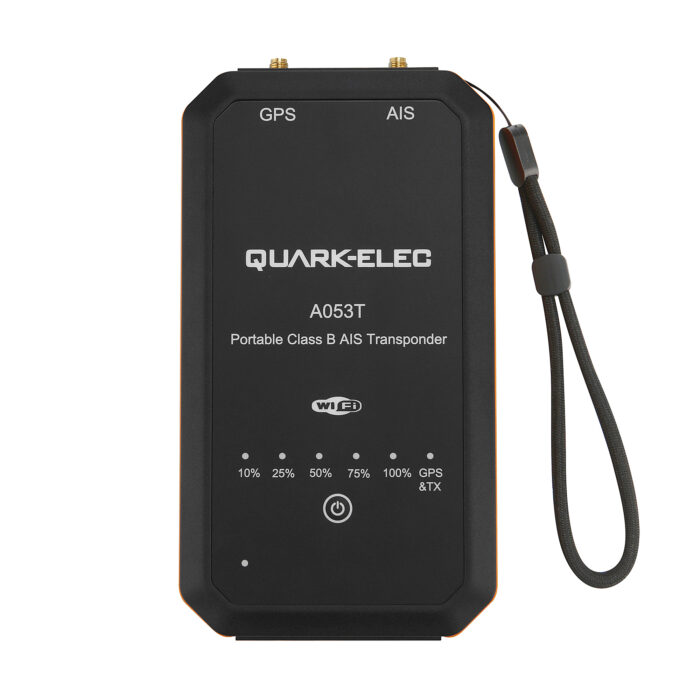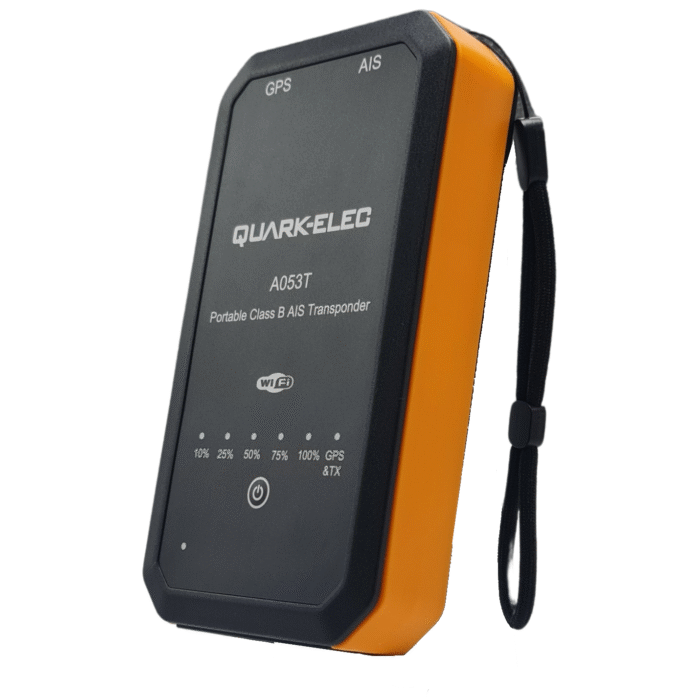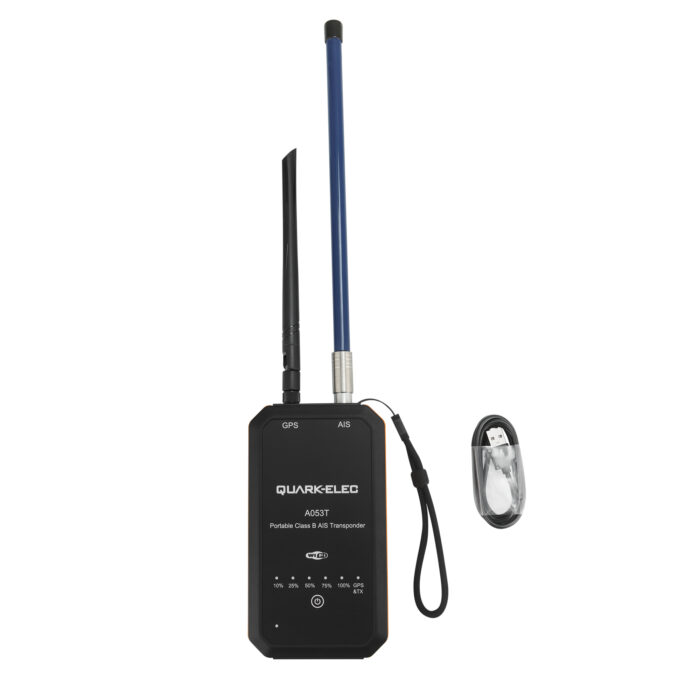Who Needs a Portable AIS? A Case for the Quark‑elec A053T Portable Class B AIS Transponder
Who Needs a Portable AIS Transponder — and Why
Over the past few years, AIS (Automatic Identification System) has proven to be one of the essential pieces of kit to found on board vessels across the globe. While you may find fixed permanent AIS Transponders/Recovers on board larger vessels, this is not always possible. Especially when it comes to smaller vessels, rentals, delivery services or the need for a temporary solution. This is where our A053T Portable Class B AIS Transponder comes into its own!
Below, we explore who can benefit from a portable AIS transponder, why it makes sense in many scenarios, and how the upcoming Quark‑elec A053T Portable AIS Transponder fits into the picture.
A quick recap: What is AIS (and what is the difference between a transponder and receiver)?
AIS is a VHF‑based system used by vessels to broadcast (transmit) and receive identification and navigational data (position, course, speed, etc.). Ships, shore stations, and other AIS‑equipped craft can “see” other vessel’s AIS transmissions, improving situational awareness, collision avoidance, and traffic monitoring.
- An AIS receiver only listens (receives) AIS messages from others. (Range dependent on model and antenna condition/placement)
- An AIS transponder (often referred to as Transceiver) both transmits your vessel’s information and receives AIS data from others. There are various different ‘Class’ of Transponders, each for certain applications.
| Class | Application | Power Output |
| A | Commercial use, typical found in Cruise ships, cargo ships etc. | 12.5W |
| B | For recreational use on smaller craft or fishing vessels. Referred to as CSTDMA. | 2W |
| B+ | For use on larger vessel, bridging the gap between Class A and Class B. Referred to as SOTDMA. | 5W |
When it comes to smaller vessels, it is common practice to only have a Receiver on board (often found integrated into Chart plotters or VHF Radios to allow the function when space is at a premium), allowing the visibility of near by vessels but without being able to be seen by others. This is where the A053T can shine by providing the full transmit and receiver function from a compact and portable device without the need for permanent installation.
Use cases: Who stands to gain from a portable AIS transponder?
Here are scenarios and types of users for whom a portable AIS transponder may be especially useful:
1. Delivery Skippers and Crew who Transfer Between Boats
If you skipper multiple boats (or deliver yachts), you may not want to permanently install an AIS transponder on each. A portable unit allows you to program your device to which ever vessel you will operating, ensuring they remain safe and legal during the crossing.
2. Charter Fleets / Rental Boats
Charter companies often rotate boats, refit them, or lend them to guests. A portable unit can be taken on and off, simplifying installation logistics. Guests or interim captains can bring their own AIS identity. It also reduces the need to wire every rental boat during downtime.
3. Occasional or Seasonal Boaters
Some owners don’t keep their vessels in the water year‑round or may store them ashore. Installing a fixed AIS may be inconvenient or vulnerable to theft or vandalism. A portable transponder lets them conveniently bring the AIS unit ashore and only mount it at sea.
4. Safety / Emergency Backup Use
If your primary AIS fails, or if you find yourself in a vessel without AIS, a portable unit can act as a backup. In rescue or emergency operations, it may be used to broadcast your location. It can also be used temporarily when increased visibility is desired.
5. Smaller Vessels Without Pre‑wired Infrastructure
Some smaller craft lack the wiring, standard connectors, or space for a permanent transponder setup. A lightweight, portable unit with minimal setup (power, antenna) can be more practical for installation and use.
What to expect / what’s attractive in a portable AIS transponder
A well‑designed portable AIS transponder needs to strike a balance between capability and portability. Here are desirable features (and constraints) to look for:
| Feature | Importance |
| Battery / internal power | To work standalone or without relying on boat wiring |
| Rechargeable capacity / runtime | Allows for up to 20 hours of use between charges, remains fully functional while on charge |
| Compact, rugged design | For ease of transport and marine environment durability |
| WiFi / wireless interface | To stream AIS and GPS data to tablets, phones, or charting apps |
| Standard connectors (VHF / GPS / antenna ports) | To be compatible with existing antennas or quick plug‑in |
| Configuration via WiFi | To allow for one the go configuration |
| Regulatory compliance / class specification | To ensure your transmissions meet maritime AIS standards |
Portable vs Fixed, the differences between the two solutions
- Flexibility and portability — move it between vessels or remove it for storage.
- Reduced installation cost / labor — fully portable with no permanent fixing or wring required, reducing time, cost and effort.
- Backup capability — if the fixed AIS system fails, the portable unit can be swapped in quickly.
- Non‑intrusive in small craft — for small or minimalist boats, a portable unit is less invasive.
- Rental / charter convenience — owners don’t have to maintain AIS on every boat permanently.
However, it’s not a magical solution: performance (range, antenna height, battery limitations) will always be constrained relative to a full fixed installation. Also, legal/regulatory obligations still apply: your AIS broadcasts must respect local rules, and vessel registration (MMSI assignment) must be in place. Due to this, we have a process and structure in place for our fixed solutions (able to be reset by ourselves or distributors) and also our portable solution (programmable remotely with authorisation from ourselves and records of MMSI details kept).
If you are set on upgrading to a permanent fixed solution, consider our A051T (Class B) or A052T (Class B+) Transponder options. Both pack a significant punch in terms of features, performance and range.
Bottom line and recommendations
If you are:
- Skippering multiple vessels or doing deliveries
- Operating a charter or rental fleet
- Occasional boater, trailerboat, or lack existing AIS wiring
- Want a safety or emergency fallback
- Or planning to try AIS functionality without committing to full installations
then a portable AIS transponder is compelling.
With the A053T having a 15 hour battery life, WiFI configuration, WiFi connectivity to show AIS targets being received, comparable GPS and VHF antennas included, USB type C charge port and light weight and compact design, it will bring unique vantage point to the AIS market.





